
Nepenthes rafflesiana, or Raffles' pitcher-plant, is a species of tropical pitcher plant. It has a very wide distribution covering Borneo, Sumatra, Peninsular Malaysia, and Singapore. Nepenthes rafflesiana is extremely variable, with numerous forms and varieties described. In Borneo alone, there are at least three distinct varieties. The giant form of this species produces enormous pitchers rivalling those of N. rajah in size.
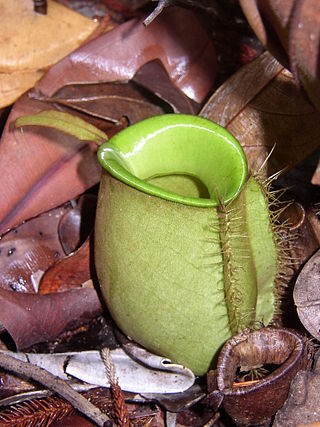
Nepenthes ampullaria is a very distinctive and widespread species of tropical pitcher plant, present in Borneo, the Maluku Islands, New Guinea, Peninsular Malaysia, Singapore, Sumatra, and Thailand.
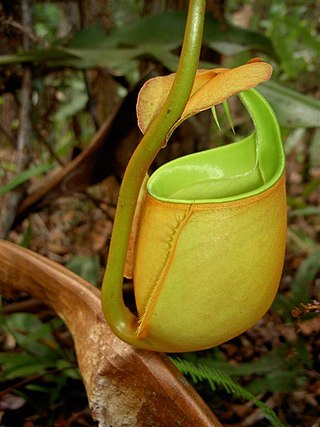
Nepenthes bicalcarata, also known as the fanged pitcher-plant, is a tropical pitcher plant endemic to northwestern Borneo, Indonesia. It is a myrmecophyte noted for its mutualistic association with a species of ant, Camponotus schmitzi. As an ant-fed plant it lacks many of the features that characterise the carnivorous syndrome in Nepenthes, including viscoelastic and highly acidic pitcher fluid, the waxy zone of the pitcher interior, and possibly even functional digestive enzymes.

Nepenthes truncata is a tropical pitcher plant endemic to the Philippines. It is known from the islands of Dinagat, Leyte, and Mindanao. The species grows at an elevation of 0–1500 m above sea level. Nepenthes truncata is characterised by its heart-shaped (truncate) leaves and very large pitchers, which can reach up to 40 cm in height.
Dr. Charles M. Clarke is an ecologist and botanist specialising in the carnivorous plant genus Nepenthes, for which he is regarded as a world authority. Clarke has an honours degree in Botany from Monash University in Melbourne, and a Ph.D. in Ecosystem management at the University of New England, in Armidale, New South Wales.
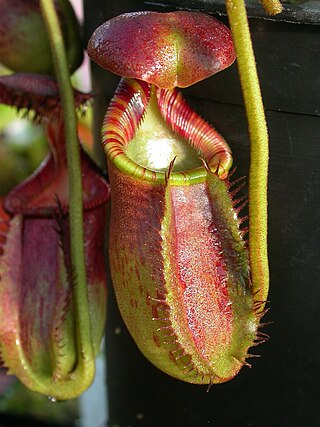
Nepenthes ephippiata, or the saddle-leaved pitcher-plant, is a tropical pitcher plant endemic to Borneo. It occurs in the Hose Mountains of central Sarawak, as well as Mount Raya and Bukit Lesung in Kalimantan. Non-climbing plants from the Hose Mountains appear to have less decurrent leaf attachment than specimens from Central Kalimantan, however the characteristic saddle after which the species is named is fully developed in climbing plants. Nepenthes ephippiata is closely related to N. lowii.

Nepenthes macrophylla, the large-leaved pitcher-plant, is a tropical pitcher plant known only from a very restrictive elevation on Mount Trusmadi in Sabah, Malaysian Borneo.

Nepenthes hispida is a tropical pitcher plant species native to Borneo. It grows at elevations of 100 to 800 m in kerangas forest. It is known with certainty only from Lambir Hills National Park and surrounding areas.

Nepenthes vogelii is a tropical pitcher plant endemic to Borneo. It is thought to be most closely related to N. fusca.
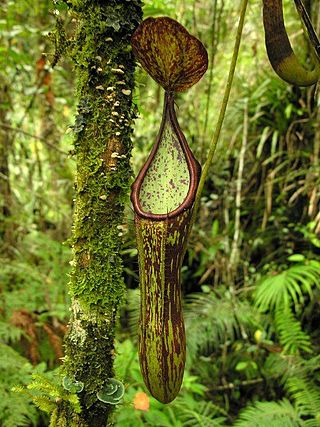
Nepenthes copelandii is a species of pitcher plant native to the island of Mindanao in the Philippines. Originally known from Mount Apo near Davao City and Mount Pasian near Bislig, it has since been discovered on a number of peaks throughout Mindanao. It may also be present on the nearby island of Camiguin. The species has a wide altitudinal distribution of 1100–2400 m above sea level. Nepenthes copelandii has no known natural hybrids. No forms or varieties have been described.
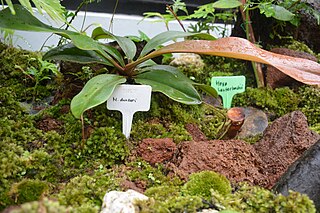
Nepenthes danseri is a species of tropical pitcher plant. It is known only from the northern coast of Waigeo Island; plants from Halmahera, the largest of the Maluku Islands, are now recognised as belonging to a separate species, N. halmahera.
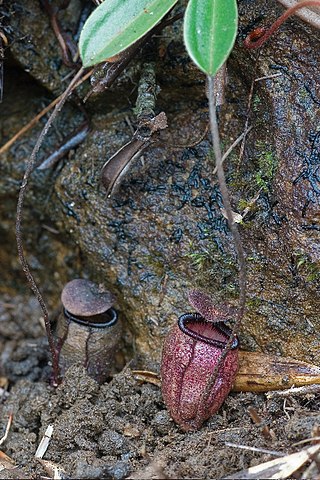
Nepenthes argentii is a highland Nepenthes pitcher plant native to Mount Guiting-Guiting on Sibuyan Island in the Philippines. It is possibly the smallest species in the genus and does not appear to have a climbing stage.
Ch'ien C. Lee is a photographer and botanist specialising in the carnivorous plant genus Nepenthes. Lee has described several new Nepenthes species, including N. baramensis, N. chaniana, N. gantungensis, N. glandulifera, N. jamban, N. lingulata, N. palawanensis, N. pitopangii, N. platychila, and N. harauensis. Lee also described the natural hybrid N. × bauensis.

"The Nepenthaceae of the Netherlands Indies" is a seminal monograph by B. H. Danser on the tropical pitcher plants of the Dutch East Indies and surrounding regions. It was originally published in the Bulletin du Jardin Botanique de Buitenzorg in 1928, and reprinted by Natural History Publications (Borneo) in 2006.
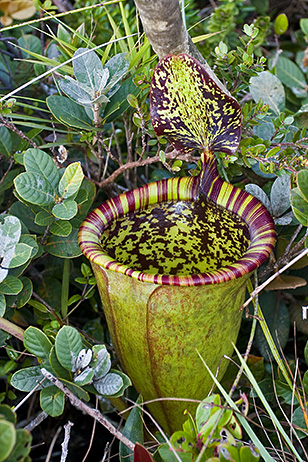
Nepenthes attenboroughii, or Attenborough's pitcher plant, is a montane species of carnivorous pitcher plant of the genus Nepenthes. It is named after the celebrated broadcaster and naturalist Sir David Attenborough, who is a keen enthusiast of the genus. The species is characterised by its large and distinctive bell-shaped lower and upper pitchers and narrow, upright lid. The type specimen of N. attenboroughii was collected on the summit of Mount Victoria, an ultramafic mountain in central Palawan, the Philippines.

Nepenthes of Borneo is a monograph by Charles Clarke on the tropical pitcher plants of Borneo. It was first published in 1997 by Natural History Publications (Borneo), and reprinted in 2006. Clarke describes it as "primarily an ecological monograph".

Nepenthes hemsleyana is a tropical pitcher plant endemic to Borneo, where it grows in peat swamp forest and heath forest below 200 m above sea level.

















